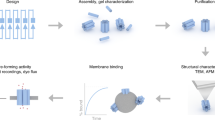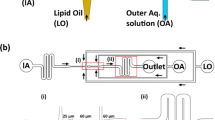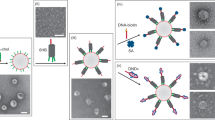Abstract
We describe micromanipulation and microinjection procedures for the fabrication of soft-matter networks consisting of lipid bilayer nanotubes and surface-immobilized vesicles. These biomimetic membrane systems feature unique structural flexibility and expandability and, unlike solid-state microfluidic and nanofluidic devices prepared by top-down fabrication, they allow network designs with dynamic control over individual containers and interconnecting conduits. The fabrication is founded on self-assembly of phospholipid molecules, followed by micromanipulation operations, such as membrane electroporation and microinjection, to effect shape transformations of the membrane and create a series of interconnected compartments. Size and geometry of the network can be chosen according to its desired function. Membrane composition is controlled mainly during the self-assembly step, whereas the interior contents of individual containers is defined through a sequence of microneedle injections. Networks cannot be fabricated with other currently available methods of giant unilamellar vesicle preparation (large unilamellar vesicle fusion or electroformation). Described in detail are also three transport modes, which are suitable for moving water-soluble or membrane-bound small molecules, polymers, DNA, proteins and nanoparticles within the networks. The fabrication protocol requires ∼90 min, provided all necessary preparations are made in advance. The transport studies require an additional 60–120 min, depending on the transport regime.
This is a preview of subscription content, access via your institution
Access options
Subscribe to this journal
Receive 12 print issues and online access
$259.00 per year
only $21.58 per issue
Buy this article
- Purchase on Springer Link
- Instant access to full article PDF
Prices may be subject to local taxes which are calculated during checkout












Similar content being viewed by others
References
Belting, M. & Wittrup, A. Nanotubes, exosomes, and nucleic acid-binding peptides provide novel mechanisms of intercellular communication in eukaryotic cells: implications in health and disease. J. Cell Biol. 183, 1187–1191 (2008).
Whitesides, G.M. The 'right' size in nanobiotechnology. Nat. Biotechnol. 21, 1161–1165 (2003).
Davis, D.M. & Sowinski, S. Membrane nanotubes: dynamic long-distance connections between animal cells. Nat. Rev. Mol. Cell Biol. 9, 431–436 (2008).
Veranic, P. et al. Different types of cell-to-cell connections mediated by nanotubular structures. Biophys. J. 95, 4416–4425 (2008).
Hurtig, J., Chiu, D.T. & Onfelt, B. Intercellular nanotubes: insights from imaging studies and beyond. Wiley Interdiscip. Rev. Nanomed. Nanobiotechnol. 2, 260–276 (2010).
Onfelt, B. et al. Structurally distinct membrane nanotubes between human macrophages support long-distance vesicular traffic or surfing of bacteria. J. Immunol. 177, 8476–8483 (2006).
Gurke, S., Barroso, J.F.V. & Gerdes, H.H. The art of cellular communication: tunneling nanotubes bridge the divide. Histochem. Cell Biol. 129, 539–550 (2008).
Lucas, W.J., Ham, L.K. & Kim, J.Y. Plasmodesmata—bridging the gap between neighboring plant cells. Trends Cell Biol. 19, 495–503 (2009).
Lone, B. Computational nanotechnology in biomedical nanometrics and Nano-materials. J. Comput. Theor. Nanosci. 6, 2146–2151 (2009).
Yum, K., Wang, N. & Yu, M.F. Nanoneedle: a multifunctional tool for biological studies in living cells. Nanoscale 2, 363–372 (2010).
Wong, I.Y., Almquist, B.D. & Melosh, N.A. Dynamic actuation using nano-bio interfaces. Materials Today 13, 14–22 (2010).
Shvedova, A.A., Kagan, V.E. & Fadeel, B. Close encounters of the small kind: adverse effects of man-made materials interfacing with the nano-cosmos of biological systems. Annu. Rev. Pharmacol. Toxicol. 50, 63–88 (2010).
Fadeel, B., Kasemo, B., Malmsten, M. & Stromme, M. Nanomedicine: reshaping clinical practice. J. Intern. Med. 267, 2–8 (2010).
Karlsson, A. et al. Molecular engineering—networks of nanotubes and containers. Nature 409, 150–152 (2001).
Karlsson, M. et al. Biomimetic nanoscale reactors and networks. Annu. Rev. Phys. Chem. 55, 613–649 (2004).
Karlsson, A. et al. Controlled initiation of enzymatic reactions in micrometer-sized biomimetic compartments. J. Phys. Chem. B 109, 1609–1617 (2005).
Bauer, B., Davidson, M. & Orwar, O. Direct reconstitution of plasma membrane lipids and proteins in nanotube-vesicle networks. Langmuir 22, 9329–9332 (2006).
Walde, P., Cosentino, K., Engel, H. & Stano, P. Giant vesicles: preparations and applications. Chem. Bio. Chem. 11, 848–865 (2010).
Criado, M. & Keller, B.U. A membrane fusion strategy for single-channel recordings of membranes usually non-accessible to patch-clamp pipette electrodes. FEBS Lett. 224, 172–176 (1987).
Karlsson, M. et al. Micropipet-assisted formation of microscopic networks of unilamellar lipid bilayer nanotubes and containers. Langmuir 17, 6754–6758 (2001).
Lasic, D.D. Liposomes: From Physics to Applications (Elsevier Science, 1993).
Luisi, P.L. & Walde, P. Giant Vesicles (Wiley, 1999).
Barber, M.A. The pipette method in the isolation of single microorganisms and in the inoculation of substances into living cells. Phillipp. J. Sci. B. Trop. Med. 9, 307–360 (1914).
Taylor, C.V. An accurately controllable micropipette. Science 51, 617–618 (1920).
Hamill, O.P., Marty, A., Neher, E., Sakmann, B. & Sigworth, F.J. Improved patch-clamp techniques for high-resolution current recording from cells and cell-free membrane patches. Pflugers Arch. Eur. J. Physiol. 391, 85–100 (1981).
Neumann, E., Schaeferridder, M., Wang, Y. & Hofschneider, P.H. Gene-transfer into mouse lyoma cells by electroporation in high electric-fields. EMBO J. 1, 841–845 (1982).
Lundqvist, J.A. et al. Altering the biochemical state of individual cultured cells and organelles with ultramicroelectrodes. Proc. Natl. Acad. Sci. USA 95, 10356–10360 (1998).
Wang, M.Y., Orwar, O., Olofsson, J. & Weber, S.G. Single-cell electroporation. Anal. Bioanal. Chem. 397, 3235–3248 (2010).
Karlsson, M. et al. Electroinjection of colloid particles and biopolymers into single unilamellar liposomes and cells for bioanalytical applications. Anal. Chem. 72, 5857–5862 (2000).
Davidson, M. et al. Fluid mixing in growing microscale vesicles conjugated by surfactant nanotubes. J. Am. Chem. Soc. 127, 1251–1257 (2005).
Sott, K. et al. Controlling enzymatic reactions by geometry in a biomimetic nanoscale network. Nano Lett. 6, 209–214 (2006).
Lizana, L. & Konkoli, Z. Diffusive transport in networks built of containers and tubes. Phys. Rev. E 72, 026305 (2005).
Lizana, L., Konkoli, Z. & Orwar, O. Tunable filtering of chemical signals in a simple nanoscale reaction-diffusion network. J. Phys. Chem. B 111, 6214–6219 (2007).
Karlsson, R. et al. Moving-wall-driven flows in nanofluidic systems. Langmuir 18, 4186–4190 (2002).
Tokarz, M. et al. Single-file electrophoretic transport and counting of individual DNA molecules in surfactant nanotubes. Proc. Natl. Acad. Sci. USA 102, 9127–9132 (2005).
Tokarz, M., Hakonen, B., Dommersnes, P., Orwar, O. & Akerman, B. Electrophoretic transport of latex particles in lipid nanotubes. Langmuir 23, 7652–7658 (2007).
Dommersnes, P.G., Orwar, O., Brochard-Wyart, F. & Joanny, J.F. Marangoni transport in lipid nanotubes. Europhys. Lett. 70, 271–277 (2005).
Lobovkina, T., Dommersnes, P., Hurtig, J., Joanny, J.F. & Orwar, O. Zipper dynamics of surfactant nanotube junctions. Phys. Rev. Lett. 97, 188105/188101–188105/188104 (2006).
Evans, E. & Rawicz, W. Entropy-driven tension and bending elasticity in condensed-fluid membranes. Phys. Rev. Lett. 64, 2094–2097 (1990).
Lobovkina, T., Dommersnes, P.G., Tiourine, S., Joanny, J.F. & Orwar, O. Shape optimization in lipid nanotube networks. Eur. Phys. J. E 26, 295–300 (2008).
Lizana, L., Bauer, B. & Orwart, O. Controlling the rates of biochemical reactions and signaling networks by shape and volume changes. Proc. Natl. Acad. Sci. USA 105, 4099–4104 (2008).
Lobovkina, T. et al. Mechanical tweezer action by self-tightening knots in surfactant nanotubes. Proc. Natl. Acad. Sci. USA 101, 7949–7953 (2004).
Karlsson, M. et al. Formation of geometrically complex lipid nanotube-vesicle networks of higher order topologies. Proc. Natl. Acad. Sci. USA 99, 11573–11578 (2002).
Onoue, Y. et al. A giant liposome for single-molecule observation of conformational changes in membrane proteins. Biochim. Biophys. Acta Biomemb. 1788, 1332–1340 (2009).
Sparreboom, W., van den Berg, A. & Eijkel, J.C.T. Principles and applications of nanofluidic transport. Nat. Nanotechnol. 4, 713–720 (2009).
Fernandes, P. Miniaturization in biocatalysis. Int. J. Mol. Sci. 11, 858–879 (2010).
Lee, L.J. Polymer nanoengineering for biomedical applications. Ann. Biomed. Eng. 34, 75–88 (2006).
Napoli, M., Eijkel, J.C.T. & Pennathur, S. Nanofluidic technology for biomolecule applications: a critical review. Lab Chip 10, 957–985 (2010).
Sparreboom, W., van den Berg, A. & Eijkel, J.C.T. Transport in nanofluidic systems: a review of theory and applications. New J. Phys. 12, 015004 doi:015004 10.1088/1367-2630/12/1/015004 (2010).
Charras, G.T. A short history of blebbing. J. Microsc. 231, 466–478 (2008).
Chan, Y.H.M. & Boxer, S.G. Model membrane systems and their applications. Curr. Opin. Chem. Biol. 11, 581–587 (2007).
Jelinek, R. & Silbert, L. Biomimetic approaches for studying membrane processes. Mol. BioSyst. 5, 811–818 (2009).
Kirby, C. & Gregoriadis, G. Dehydration-rehydration vesicles—a simple method for high-yield drug entrapment in liposomes. Nat. Biotechnol. 2, 979–984 (1984).
Kikuchi, H., Yamauchi, H. & Hirota, S. A spray-drying method for mass-production of liposomes. Chem. Pharma. Bull. 39, 1522–1527 (1991).
Angelova, M.I. & Dimitrov, D.S. Liposome electroformation. Faraday Discuss. Chem. Soc. 81, 303–311 (1986).
Kuribayashi, K., Tresset, G., Coquet, P., Fujita, H. & Takeuchi, S. Electroformation of giant liposomes in microfluidic channels. Measure. Sci. Technol. 17, 3121–3126 (2006).
Estes, D.J. & Mayer, M. Electroformation of giant liposomes from spin-coated films of lipids. Colloids Surf. B Biointerfaces 42, 115–123 (2005).
Estes, D.J. & Mayer, M. Giant liposomes in physiological buffer using electroformation in a flow chamber. Biochim. Biophys. Acta Biomemb. 1712, 152–160 (2005).
Liu, H.Q. et al. Lipid nanotube formation from streptavidin-membrane binding. Langmuir 24, 3686–3689 (2008).
Roux, A. et al. A minimal system allowing tubulation with molecular motors pulling on giant liposomes. Proc. Natl. Acad. Sci. USA 99, 5394–5399 (2002).
Pascoal, P., Kosanic, D., Gjoni, M. & Vogel, H. Membrane nanotubes drawn by optical tweezers transmit electrical signals between mammalian cells over long distances. Lab Chip 10, 2235–2241 (2010).
Mathivet, L., Cribier, S. & Devaux, P.F. Shape change and physical properties of giant phospholipid vesicles prepared in the presence of an AC electric field. Biophys. J. 70, 1112–1121 (1996).
Perutkova, S., Kralj-Iglic, V., Frank, M. & Iglic, A. Mechanical stability of membrane nanotubular protrusions influenced by attachment of flexible rod-like proteins. J. Biomech. 43, 1612–1617 (2010).
Davidson, M., Karlsson, M., Sinclair, J., Sott, K. & Orwar, O. Nanotube-vesicle networks with functionalized membranes and interiors. J. Am. Chem. Soc. 125, 374–378 (2003).
Markstrom, M., Gunnarsson, A., Orwar, O. & Jesorka, A. Dynamic microcompartmentalization of giant unilamellar vesicles by sol gel transition and temperature induced shrinking/swelling of poly(N-isopropyl acrylamide). Soft Matter 3, 587–595 (2007).
Karlsson, A. et al. Nanofluidic networks based on surfactant membrane technology. Anal. Chem. 75, 2529–2537 (2003).
Lobovkina, T. et al. Pattern formation of different geometries and topologies as well as knotted structures in lipid nanotube networks. Biophys. J. 88, 208a (2005).
Konings, A.W.T. Lipid peroxidation in liposomes. in Liposome Technology Vol. 1 (ed. Gregoriadis, G.) 139–161 (CRC Press, 1984).
Sott, K. et al. Micropipet writing technique for production of two-dimensional lipid bilayer nanotube-vesicle networks on functionalized and patterned surfaces. Langmuir 19, 3904–3910 (2003).
Markstrom, M., Lizana, L., Orwar, O. & Jesorka, A. Thermoactuated diffusion control in soft matter nanofluidic devices. Langmuir 24, 5166–5171 (2008).
Jesorka, A., Markstrom, M. & Orwar, O. Controlling the internal structure of giant unilamellar vesicles by means of reversible temperature dependent sol-gel transition of internalized poly (N-isopropyl acrylamide). Langmuir 21, 1230–1237 (2005).
Jesorka, A. & Orwar, O. Complex nanotube-liposome networks. in Liposomes, Part F (Methods in Enzymology) Vol. 464 309–325 (Elsevier Academic, 2009).
Lizana, L., Konkoli, Z., Bauer, B., Jesorka, A. & Orwar, O. Controlling chemistry by geometry in Nanoscale systems. Annu. Rev. Phys. Chem. 60, 449–468 (2009).
Acknowledgements
We thank all previous research group members and associates, in particular, former graduate students M. Karlsson, R. Karlsson, A. Karlsson, M. Davidson, K. Sott, M. Tokarz, J. Hurtig, M. Markström, B. Bauer and T. Lobovkina, who have contributed greatly to the development of these protocols during the time they completed their individual projects. We also thank P. Dommersnes for advice and discussion. Our research was and is supported by the Royal Swedish Academy of Sciences, the Swedish Research council (VR), the Swedish Foundation for Strategic Research, the Knut and Alice Wallenberg Foundation and the European Research Council.
Author information
Authors and Affiliations
Contributions
A.J. performed the experimental procedures for network generation, Marangoni transport and took part in manuscript preparation. N.S. and H.Z. performed experimental procedures for diffusive transport. B.O. carried out lipid preparation. B.H. performed electrophoretic transport and took part in the manuscript preparation. O.O. designed the original concept and took part in the manuscript preparation.
Corresponding author
Ethics declarations
Competing interests
The authors declare no competing financial interests.
Rights and permissions
About this article
Cite this article
Jesorka, A., Stepanyants, N., Zhang, H. et al. Generation of phospholipid vesicle-nanotube networks and transport of molecules therein. Nat Protoc 6, 791–805 (2011). https://doi.org/10.1038/nprot.2011.321
Published:
Issue Date:
DOI: https://doi.org/10.1038/nprot.2011.321
This article is cited by
-
Combining patch-clamping and fluorescence microscopy for quantitative reconstitution of cellular membrane processes with Giant Suspended Bilayers
Scientific Reports (2019)
-
Sculpting and fusing biomimetic vesicle networks using optical tweezers
Nature Communications (2018)
-
Placing and shaping liposomes with reconfigurable DNA nanocages
Nature Chemistry (2017)
-
Recognizing single phospholipid vesicle collisions on carbon fiber nanoelectrode
Science China Chemistry (2017)
-
Vesicle-based artificial cells as chemical microreactors with spatially segregated reaction pathways
Nature Communications (2014)
Comments
By submitting a comment you agree to abide by our Terms and Community Guidelines. If you find something abusive or that does not comply with our terms or guidelines please flag it as inappropriate.



